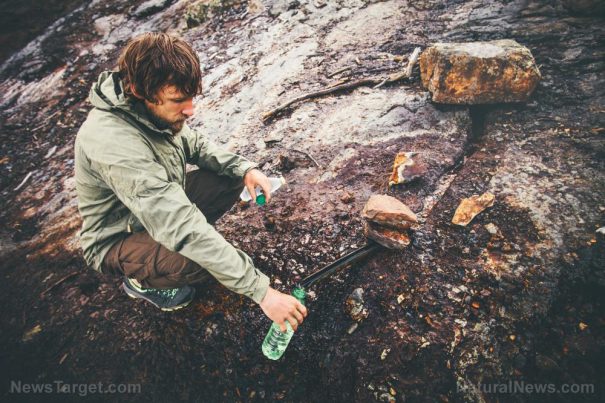What you need to know about water purification so you won’t put your life at risk
Thursday, October 25, 2018 by Zoey Sky
http://www.bugout.news/2018-10-25-what-you-need-to-know-about-water-purification.html

As a prepper, you can ensure the quality of your water supply by learning about water purification. This knowledge can also help you choose the best water bottles and filters when you’re looking for prepping gear. Refer to these five tips about water purification so you can gather potable water when you’re out in the wild or if you need a clean water source for your homestead. (h/t to Survivopedia.com)
(1) What’s the difference between water filtration and water purification?
With the exemption of minerals and pharmaceuticals, there are three types of disease-causing pathogens in water:
- Bacteria – You can find bacteria like E. coli or salmonella in water. To ensure that the water you’re about to drink is free from bacteria, use a 0.1-micron filter. Alternatively, a 1-micron filter can capture 99.9 percent of bacteria. A micron is a unit of measurement that’s equal to one-millionth of a meter in length (or 39 millionths of an inch). A micron rating indicates the ability of a liquid filter to eliminate contaminants by the size of the particles.
- Protozoan cysts – Protozoan cysts are minuscule “eggs” with tough shells. They die when water is boiled, but you can also filter them out. Some examples include Giardia and Cryptosporidium. Protozoan cysts can range in size from one to 300 microns.
- Viruses – Viruses are rarely found in American or Canadian waters, but this may change when disaster strikes. Viruses like hepatitis A and rotavirus may range in size from 0.005 to one micron. Viruses are too small, making filters are ineffective against them. You need to use other purification methods to remove viruses from water.
(2) What’s the difference between purified water and distilled water?
Water already contains minerals, but these minerals are eliminated when water is distilled or purified via reverse osmosis (RO). These processes remove at least 99.5 percent of the impurities from water, but they also remove the “good” minerals.
People who advocate water re-mineralization do so for several reasons:
- The human body requires minerals, especially if you’re not eating healthy foods or if you’ve been sweating a lot. The primary minerals that the body needs to replenish include calcium, magnesium, potassium, and salt.
- Re-mineralized water can quench thirst better and the body absorbs it faster. When you add minerals back to water, you also boost its pH and restore it to an alkaline state. This makes water ionized, meaning the water molecules cluster into smaller groups so the body can absorb it faster.
- Re-mineralized water tastes better. The human palate is used to the flavor of mineral-rich water, and re-mineralizing water gives it a fuller flavor that some people may prefer compared to distilled water.
(3) Reverse osmosis and distillation alone can’t eliminate harmful agents.
With RO, clean water is filtered out while the brine/excess water is disposed of. Most reverse osmosis systems produce at least three gallons of brine to make one gallon of fresh water.
To make up for the lost water, preppers re-route brine to a container so the excess can be used to water plants. The brine can also be used for processes that don’t need purified water.
The distillation process simulates the hydrologic cycle of evaporation (boiling to steam), precipitation (precipitation in an apparatus, e.g., a condensing coil), and condensation leading to rain (water cooled via a fan that then drips into a sterile container). Like water, some chemicals evaporate and re-condense and pass through with the “pure” water.
When choosing a water filter, keep in mind that high-quality RO and distiller units come with a reliable carbon filtration, like a carbon block, to safely eliminate various contaminants. (Related: Preppers chemistry: How to make your own activated charcoal water filter and hand warmers.)
(4) Drinking saltwater will kill you faster than thirst.
The fastest ways to die of dehydration is to consume saltwater. Thankfully, scientific advancements have determined various ways to make saltwater safe to drink.
One such method is through desalination or removing the water’s salt content. In a survival method, you can do this by distilling the water through evaporation.
Another method that you can use is heat. Heat the saltwater until it steams, then capture the steam to gather potable water. Doing this makes the water evaporate while the salt and other impurities are left behind. While this method requires a lot of energy (e.g., heat), it’s a cost-efficient way of gathering water because you won’t waste too much fuel like with boiling.
(5) Tap water isn’t safe to drink.
Did you know that at least two million Americans get sick because of water contamination? The next time you feel thirsty, step away from the tap and pour some water from a water filter pitcher instead. Just because water comes from the tap means its automatically safe to drink. Water can easily get contaminated because of outdated plumbing or equipment that don’t filter out modern contaminants like chemicals and pharmaceuticals.
If you have a well in your property, drought, flooding, hydraulic fracking, or mining activity in the area may disrupt the water tables and contaminate the water. Streams and other unpurified water sources can get polluted with chemicals (like antibiotics, fertilizers, and pesticides) because of runoff from farms or industrial plants. These water sources can also be exposed to leaky sewage systems and animal waste. Additionally, acid rain and smog can pollute water.
When testing water, keep an eye out for common contaminants and pollutants like arsenic, fluoride, hexavalent chromium/Chromium 6, and lead.
Keep these five important tips in mind when filtering or purifying water so you can stay safe even after SHTF.
You can read more articles about water safety at CleanWater.news.
Sources include:

